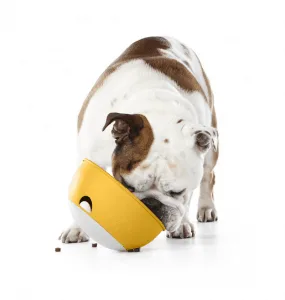
January is just about synonymous with weight loss. Let’s face it: we all tend to overindulge over the holidays. Coupled with the bad weather that all too often keeps us indoors (or gives us a handy excuse for staying in), the pounds can pack on–not only on us but on our dogs.
One of Tiki’s New Year’s resolutions is to lose a little weight. We’ve already started adding salt-free green beans to her meals, helping her to feel full without packing on the extra calories. I’m really working hard to make sure we make our usual twice-daily walks, with the goal of 45 minutes in the morning and 30 minutes in the late afternoon.
 We just received the new PAW5 Rock ‘N Bowl, designed to encourage your dog to “work” for that meal, rocking the bowl to dispense food a bit at a time and make that meal last longer–and be more FUN for her. We’re always looking for ways to enrich our dogs’ lives and mealtime is definitely their favorite part of the day–so we want to make it last longer. Tomorrow Tiki will be trying the bowl for the first time so stay tuned for her review and photos!
We just received the new PAW5 Rock ‘N Bowl, designed to encourage your dog to “work” for that meal, rocking the bowl to dispense food a bit at a time and make that meal last longer–and be more FUN for her. We’re always looking for ways to enrich our dogs’ lives and mealtime is definitely their favorite part of the day–so we want to make it last longer. Tomorrow Tiki will be trying the bowl for the first time so stay tuned for her review and photos!
Keeping that extra weight off our dogs is important for many health reasons. Today we’ve got a great guest post to share from the College of Veterinary Medicine & Biomedical Sciences, Texas A&M University (follow on Twitter) about the importance of prevent obesity in your dog:
Like humans, pets can become obese and develop excess body fat, which can lead to serious health problems, such as diabetes or degenerative joint disease. In order to provide your furry best friend with the highest quality of life and increase their life span, be sure to follow these simple steps to prevent your pet from becoming obese.
Weight gain in pets is often a result of overfeeding and lack of exercise. To keep your pet at a healthy weight, be sure to provide a healthy balance between food intake and physical activity. For example, give your dog or cat two to three meals a day instead of providing food at all times, and make sure to include at least one daily walk or some playtime.
Maintaining a healthy weight for dogs and cats also depends on the type of food they eat on a daily basis. Owners should choose an appropriate pet food according to the animal’s age, weight, and activity level. Generally, younger dogs and cats need to consume more calories per pound of body weight than older dogs and cats. Animals with active lifestyles and pregnant or nursing females require more protein, minerals, and calories in their diet.
Dr. Audrey Cook, associate professor at the Texas A&M College of Veterinary Medicine & Biomedical Sciences, explained the best way to choose the healthiest option for your pet. “Your regular veterinarian is the best person to give advice on what to feed your pet,” she said. “They will be able to provide an optimal diet type based on the animal’s age and body condition. In general, feeding guides on food products tend to overestimate the amount of food needed, so these guides can be misleading.”
In addition to diet and exercise, pet owners can regularly monitor their pet’s weight by routinely weighing them around the same time of the day. This can be effective in catching your pet’s weight increase before it becomes a more serious problem.
Obesity can also be caused by some serious health problems rather than simply reflecting poor diet and lack of exercise. Weight gain can be related to hormone problems, such as hypothyroidism in dogs and acromegaly in cats, which is defined as excess growth hormone production. Dogs with hypothyroidism gain weight without eating more food than usual, while cats with acromegaly will experience an increase in appetite. Dogs and cats with Cushing’s syndrome will appear as if they’ve gained weight with their pot-bellied appearance, but these patients rarely experience a weight increase.
No matter the cause of obesity in dogs and cats, severe secondary diseases and health problems can develop if the obese patient is left untreated. There is good evidence that obesity impacts quality of life as well as life span. “In dogs, obesity is often associated with joint problems, such as arthritis and loss of mobility,” Cook said. “Obesity in cats is strongly associated with diabetes mellitus.” In addition to these health conditions, an obese pet may also have difficulty breathing, become fatigued with routine exercise, and be unable to groom itself effectively.
Though it may be tempting to spoil your pet with table scraps and extra servings of food, consider thinking twice about the consequences your pet may face as a result. To provide your pet with a healthy and happy life, consult your veterinarian in keeping a balanced lifestyle and choosing the right food for your pet’s needs.
- Who are the Top Pet Influencers and Should Your Dog Join In the Fun? - April 10, 2024
- Should Dogs Sleep on the Bed? - April 9, 2024
- 10 Spring Cleaning Tasks for Dog Homes - April 9, 2024
